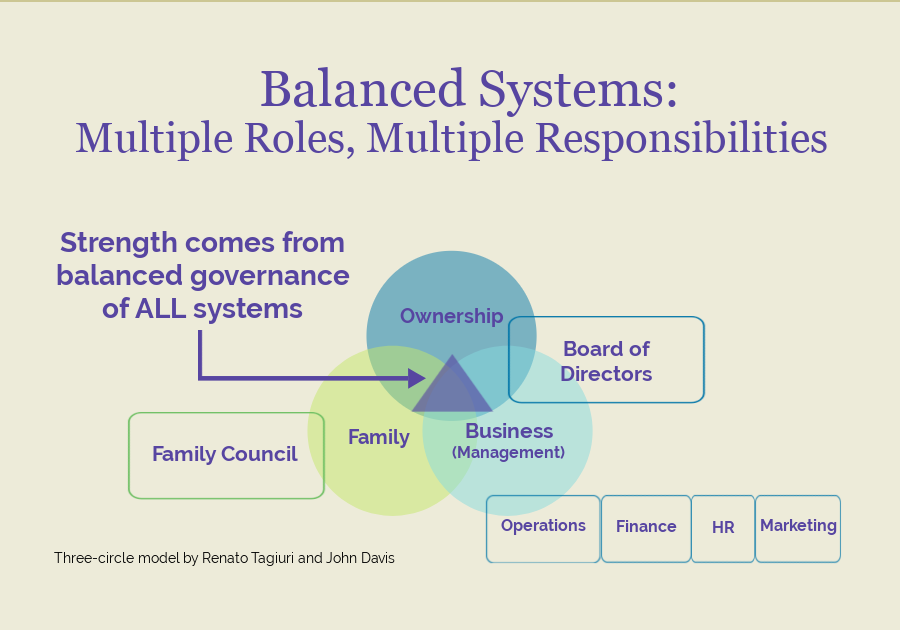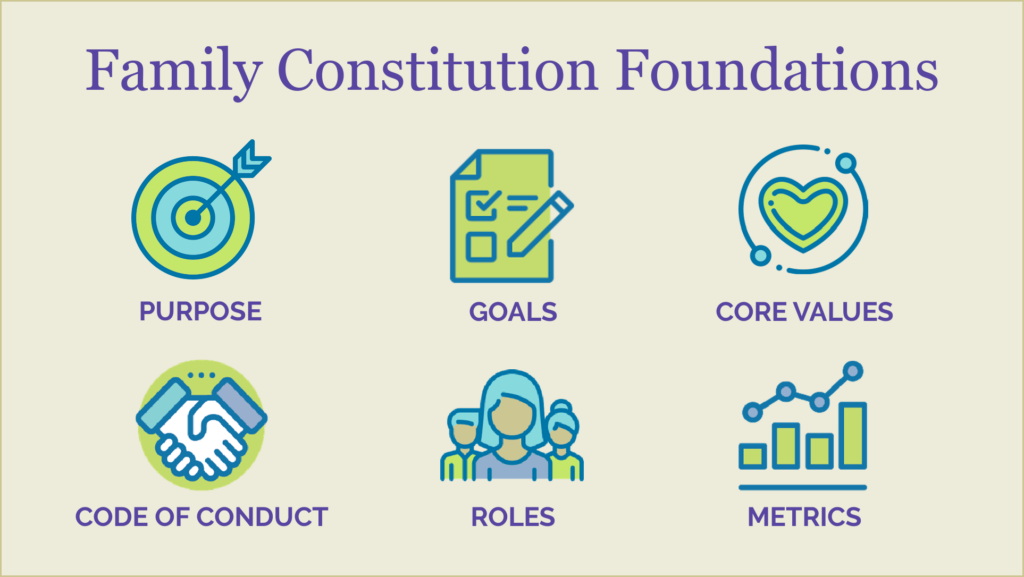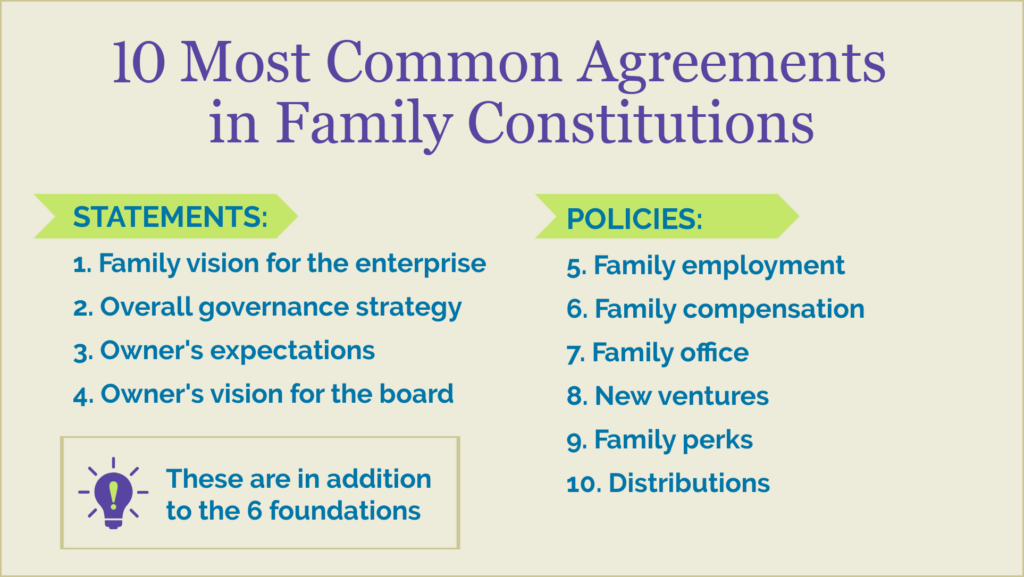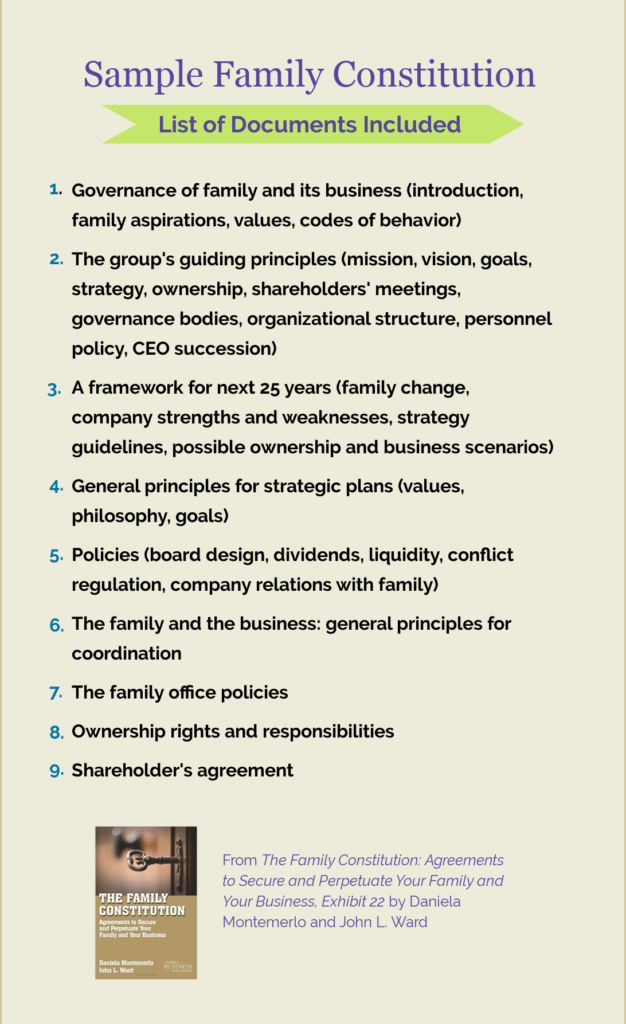A family constitution is a living document created and implemented by a family that guides their relationship inside their family enterprise. It defines their collective vision and includes principles, policies, and statements. It is intended to harness their cooperative energy, inspire them to achieve new heights, clarify roles, responsibilities and expectations, and provide guidance as they make increasingly complicated decisions. Over time, it becomes a living record of the core values, processes, and decisions that support a family as they work together to steward their enterprise into succeeding generations.
By creating a family constitution, leaders can lay out the vision that will get the family, owners, and managers rowing in the same direction. As a family enterprise grows, it becomes more complicated. Revenue growth means more employees, products, and customers. More employees require space, technology, and training. At the same time, the family grows and changes. Children grow up, pursue education, and create families of their own. Some join the family enterprise, while others retain ownership but stay away from day-to-day management. Within one generation, what started as a “mom and pop” family business can become a complex enterprise with varying perspectives and ideas. In the absence of clear goals, structures, and processes, more people voicing more opinions and pursuing individual paths will create confusion and disharmony.

Before creating a family constitution, it’s important to consider the whole concept of family enterprise governance: a system of structures (e.g., board of directors, family office, family council) and processes designed to foster constructive communication, excellent decision-making, and timely identification and solving of problems. A carefully crafted, highly customized family constitution can go a long way in helping a family enterprise improve in these important areas.
Why Do Families Choose to Create a Constitution?
In short, to get on the same page (literally!) about the stewardship of the businesses, relationships, and assets that matter most to them. For instance, let’s consider the scenario where mom and dad start, own, and operate a trucking business for 40 years. They plan to retire and pass equal shares of controlling ownership to their twin daughters. One has worked in their trucking company for 20 years as its logistics manager and the other is a dermatologist. Historically, their relationship as sisters has been excellent.
Now, there are many questions to work through before mom and dad retire. Who will lead the company? Who will make that decision? How will the daughters share the risks of owning the business? Should they grow it into a national player or keep it as a regional company? How much risk are they comfortable with? What if one of the grandkids wants a job? And how will they be compensated and evaluated? What if one sister wants to sell her half of the business?
You see the problem. If each sister owns 50 percent, neither one controls it. One has more day-to-day experience, but not as the leader. The scenario is rife for misunderstandings and tension. Without an agreement about these questions and more, the sisters’ historically strong relationship is at risk. As the owners discuss and answer these important questions together, it is crucial that they memorialize them in writing. Hence, there is a need for a guiding document like a constitution.
What Creation Process Can a Family Use that’s Valuable and Useful?
In terms of practical steps for getting started, begin by deciding who will be included in the process. The entire family including all children? Direct descendants? In-laws? Or a working committee that represents the whole? As a rule of thumb, we suggest having a group of 5–8 adults doing the heavy lifting of outlining, drafting, editing, communicating with the rest of the family, and finalizing. Ideally, they are a balanced representation of the family including branch, geography, ownership, employment, generation, and gender. They are typically volunteers who understand the benefits of creating the constitution and, perhaps most importantly, are willing to work hard to complete it.
Next, assign roles. A committee leader to keep the team focused on the goal and protect progressing drafts of the constitution. A communications coordinator to prepare and distribute notes and agendas. A logistics coordinator to ensure meetings are scheduled, meeting space is secured, and technology and other in-meeting details are taken care of (meals, refreshments, paper, plug-ins for laptops, phones, etc.). As an idea, let your family’s personality shine through here and be creative to make this process fit. For example, one family coined the term “Big Cheese” for their committee leader and another held meetings at their favorite restaurant.
Then, agree on how long and how often to schedule meetings. A typical meeting cadence is every 6–8 weeks for 3–4 hours. My preference is to begin early in the morning to take advantage of rested brains brimming with energy and ready to create. On average, the timeline for completion is between 12–18 months when the constitution team is meeting every 6–8 weeks.
What is Typically Included in a Family Constitution?
My very first client had a jewelry business in New York City. I was assigned to work on competitive strategy, so as part of my research, I met with a Wall Street analyst who knew the retail jewelry industry. I sat down with him, and he immediately asked me four questions: “Who are you? What’s important to you? Why? What are you trying to accomplish?”
I began to stumble through my answers before asking, “What made you start the meeting with those questions?” He said, “Look, we all have limited time and energy every day. I prefer to work with people who know who they are and what they’re trying to accomplish.” This exchange really stuck with me. My approach to my work was changed by the power of these questions.

A similar approach works for families who are beginning to create a constitution. In simple terms, the team is answering key questions together that, left unanswered, can cause confusion and misinterpretation. These prompts are not meant to be all-encompassing, but start here and see what else emerges:
- Purpose: Why are we in business together?
- Goals: What are we trying to accomplish?
- Core Values: What matters most to us?
- Code of Conduct: How will we communicate and solve problems together?
- Roles: Who will do what?
- Metrics: How will we measure success?
Next, decide how to organize the constitution. As family enterprise advisors we teach clients to, first, classify problems and opportunities as either family, business, or ownership-related and, then, to follow the governance structures and processes that apply in that area. Many of our client families organize their constitutions in a similar manner, with family statements and agreements first (e.g. the six foundational statements above), ownership/family office second, board third, and business policies fourth.
Then, determine what policies the family wants to create beyond the first six foundational questions. Policies and agreements, as captured in a constitution, create predictability and expectations that can de-escalate emotional interactions between family members.
To guide you, here is a list of the top 10 most common statements and policies our clients create together: family vision for the enterprise, overall governance strategy, family employment policy, family compensation policy, family office policy, new ventures policy, owner’s expectations, family perks policy, owner’s vision for the board, and distribution policy.

All policies that a family chooses to include in their constitution are important, but I want to underscore the importance of the code of conduct. All families stem from emotional roots. They’re filled with love and loyalty, but also frustration and conflict. It is essential to set and agree on clear expectations about how to communicate from the beginning, to ensure family members are listening actively, trying to understand each other, and not jumping into historical patterns of interruptions or outbursts.
Helpful Tips and Hints
A constitution can be an excellent tool for communicating high-level goals and purpose across all stakeholders in a family enterprise, including young family members, key customers and employees, and board members.
We often see conflicts erupt around shared family properties (beach house, lake house, etc.) or limited family assets (tickets to sporting events, airplane, reward points from company credit cards, etc.). A “family perks” or family shared asset policy can help manage these emotional landmines by laying out a fair process for distributing these benefits in an equitable manner.
On many occasions, former clients get back in touch with us and express gratitude for leading them through the process of developing governance and capturing it with a constitution. They point to these steps as keys to their continued business success and favorable family relationships. Keep in mind, a family constitution is not always the right answer. For instance, if the controlling generation is focused on selling to an external buyer, a constitution is less valuable. Also, if the family is experiencing significant, escalating conflict, a constitution is not the solution. Conflict in a family is normal. However, in cases where tensions are rising, emotional cutoffs are taking place, communication is becoming hurtful, and family factions are digging into battle positions, those issues will need a different approach.
Conclusion

Many dynamics that cause tension in a family enterprise can be boiled down to differing visions about the future. Working together to write a constitution can shift focus away from differences and highlight the shared ideas, beliefs, and plans that create harmony among a group of increasingly diverse family members. When done correctly, a collaborative approach will provide the chance for every person in a wide array of family member personalities — from those more inclined to experience life by sensing and feeling to those who might rely more on logic and thinking — to be included and heard.
Regarding the overall benefit of creating a constitution, Shayne W, one of our clients, put it this way: “When we first put together family governance, we were divided as a family. We were not sure how to create alignment among so many owners and different family members. The process of drafting a constitution gave us a clear purpose and objective that helped our group start to work as a team. It led to many productive conversations between different constituents in our large family as we debated policies and ideas over many months. The result was a highly effective family council and a constitution we felt great about. It helped us make sense of the relationship between our family and our businesses, and between each other. For almost 20 years now, it has provided a solid foundation for our family, shareholders, and board.”
Additional Resources
Books:
- The Family Constitution: Agreements to Secure and Perpetuate Your Family and Your Business
- Developing Family Business Policies: Your Guide to the Future
Webinar recordings:
- The Family Constitution: A Foundation for Family Alignment
- How Leading Families Make Critical Ownership Decisions
Articles:
October 3, 2024

